Appleseed Marksmanship Training Event
Appleseed Course Review
Mackey M. (Taken September 2012)
-
Appleseed Marksmanship Training
- Student: Mackey M.
- Instructors: Appleseed Volunteers
- Location: Near College Station, TX
- Weapon: AR15
- Rounds Fired: 300
- Cost: $72 (paid to RWVA) + $10/day range fee (paid to landowner)
- Student Rating: 10/10
- Course: Appleseed
About Project Appleseed:
Through Project Appleseed, the Revolutionary War Veterans Association is committed to
teaching two things: rifle marksmanship and our early American heritage. They do this
for one simple reason, the skill and knowledge of what our founding fathers left to us is
eroding in modern America and without deliberate action, they will be lost to ignorance
and apathy.
They hold weekend events across Texas, as well as the rest of the nation. Participants come
to learn the fundamentals of rifle marksmanship and hear the history of April 19 th, 1775,
the day when our nation was born. The skill level of the attendees ranges from absolute
beginners to experienced marksmanship competitors. There is something for everyone.

Detailed review:
First I should state that I am almost a perfect novice with a rifle. Some of you might be
inclined to stop reading immediately—after all, what can you learn from a rank amateur?
Well, if you happen to be in the business of teaching marksmanship skills (or evaluating
classes) to rank amateurs, perhaps a great deal. First, let me talk about my expectations for
this Appleseed shoot.
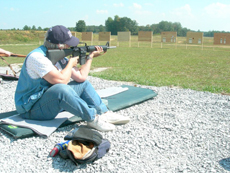 I am tentatively planning to make another journey to Front Sight in the spring of 2013, to
take the 4-Day Practical Rifle course. Having done a modicum of research about what I
would need for that class, I decided a .223 caliber rifle would be optimum. (After about 15-
20 shots from my deer rifle, a Win .270, I—my shoulder, in particular—would be done for
the entire week!) So, I recently
undertook a project to acquire—
nay build—an AR15 of my very
own. That project, in itself, has
been quite an odyssey! Long story
short, my Barbie gun (it's all about
the accessories!) is now complete.
I have taken it to the range about 4
times to break in the barrel and to get it sighted in. (The original plan
was to use a Burris Fast Fire II red
dot sight, but that didn't work
out—long story for another day.) I
would guess that I fired roughly
300 rounds during those initial trips to the range. All of those rounds were fired from a
bench. That is the only way I can shoot at the two public shooting ranges where I live. Most
of my shots were fired from a rifle rest (a Lead Sled knock-off). Having achieved what I
thought was a sighted in rifle, I was ready to actually get some hands-on training with it.
That is what I had hoped to gain from my Appleseed experience.
I am tentatively planning to make another journey to Front Sight in the spring of 2013, to
take the 4-Day Practical Rifle course. Having done a modicum of research about what I
would need for that class, I decided a .223 caliber rifle would be optimum. (After about 15-
20 shots from my deer rifle, a Win .270, I—my shoulder, in particular—would be done for
the entire week!) So, I recently
undertook a project to acquire—
nay build—an AR15 of my very
own. That project, in itself, has
been quite an odyssey! Long story
short, my Barbie gun (it's all about
the accessories!) is now complete.
I have taken it to the range about 4
times to break in the barrel and to get it sighted in. (The original plan
was to use a Burris Fast Fire II red
dot sight, but that didn't work
out—long story for another day.) I
would guess that I fired roughly
300 rounds during those initial trips to the range. All of those rounds were fired from a
bench. That is the only way I can shoot at the two public shooting ranges where I live. Most
of my shots were fired from a rifle rest (a Lead Sled knock-off). Having achieved what I
thought was a sighted in rifle, I was ready to actually get some hands-on training with it.
That is what I had hoped to gain from my Appleseed experience.
On the whole, I'd say I achieved my goal of learning how to handle my rifle a little bit better.
Additionally, I learned what marksmanship is all about and what it takes to acquire that
skill. I really don't know, yet, what to expect from Front Sight's 4-Day Practical Rifle course,
but I expect it will require much (or all) of the same skills I learned at Appleseed. I don't
recall having seen any shooting benches out there at Front Sight, so I expect that all of our
shooting will be done from the same positions taught at Appleseed: prone, cross legged,
kneeling, and standing. This is the first thing, and quite possibly one of the most difficult
things, to learn at Appleseed: building a solid shooting platform for the rifle.
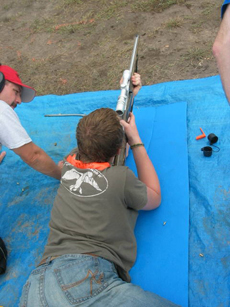 At Front Sight, I expect we will hear a good bit about making use of our slings to improve
accuracy, as well. This was one factor that proved me totally unprepared! I had done a
great deal of research on AR15 slings, attachment points, etc., and I had purchased a couple
2-point slings. The first of the two, while downright cheap (thank you, China), did not seem
to be something I could use at all. The latest one I settled on, a non-padded version of the
VTAC 2-point tactical sling, has a basic 1" strap and a tri-glide quick-adjust fastener. I used
various QD connectors to attach the VTAC to my Magpul MOE hand guard and Safariland
Superstoc butt stock. Those may ultimately prove adequate for tactical maneuvers, but it
just did not work for how they were teaching us to use a sling for building a rock solid
shooting platform for the rifle (a very important Appleseed concept). The main reason it
would not work for the Appleseed method is that my front QD attachment point is placed
at the rear of the hand guard. To use a sling the way they taught us at Appleseed, I need a front attachment
point at the front of the hand guard, or better still, if possible, attach it to the front gas
block. One of the instructors, not at all new to dealing with ill-prepared students, lent me a
sling to use for the entire class. In fact, he has a supply of WWII GI slings that fit the
intended purpose for the class. (Note: the same sling that worked for Appleseed would not
be satisfactory for a modern war fighter using the AR platform, especially in tactical
scenarios.) But just providing the sling was not sufficient; we needed some way to attach
the sling to my fore end. Enter the term "Appleseed Engineering". This involved threading
a zip tie through my MOE to make an impromptu (albeit far less than optimum) forward
attachment point. From what I learned in this class, I'm going to need to invest in some
additional QD hardware for Barbie.
At Front Sight, I expect we will hear a good bit about making use of our slings to improve
accuracy, as well. This was one factor that proved me totally unprepared! I had done a
great deal of research on AR15 slings, attachment points, etc., and I had purchased a couple
2-point slings. The first of the two, while downright cheap (thank you, China), did not seem
to be something I could use at all. The latest one I settled on, a non-padded version of the
VTAC 2-point tactical sling, has a basic 1" strap and a tri-glide quick-adjust fastener. I used
various QD connectors to attach the VTAC to my Magpul MOE hand guard and Safariland
Superstoc butt stock. Those may ultimately prove adequate for tactical maneuvers, but it
just did not work for how they were teaching us to use a sling for building a rock solid
shooting platform for the rifle (a very important Appleseed concept). The main reason it
would not work for the Appleseed method is that my front QD attachment point is placed
at the rear of the hand guard. To use a sling the way they taught us at Appleseed, I need a front attachment
point at the front of the hand guard, or better still, if possible, attach it to the front gas
block. One of the instructors, not at all new to dealing with ill-prepared students, lent me a
sling to use for the entire class. In fact, he has a supply of WWII GI slings that fit the
intended purpose for the class. (Note: the same sling that worked for Appleseed would not
be satisfactory for a modern war fighter using the AR platform, especially in tactical
scenarios.) But just providing the sling was not sufficient; we needed some way to attach
the sling to my fore end. Enter the term "Appleseed Engineering". This involved threading
a zip tie through my MOE to make an impromptu (albeit far less than optimum) forward
attachment point. From what I learned in this class, I'm going to need to invest in some
additional QD hardware for Barbie.
I can pretty much summarize what a student is taught at Appleseed by describing the Six Steps to Making a Shot:
- 1. Proper sight alignment
- 2. Proper sight picture
- 3. Respiratory pause
- 4. Focus
a. Your eye on the front sight
b. Your mind on keeping the front sight on the target - Sq-e-eze the trigger (and hold it back)
- Follow through
a. Keep your eyes open
b. Call your shots

I can easily say that I have not mastered the "Six Steps to Making a Shot". If I had, I might have earned my Appleseed Rifleman patch this weekend; but alas, I shall have to attend another Appleseed shoot, in the future, and make good on my next attempt.
Some of what I learned in my first (and only,
so far) 4-Day Defensive Handgun class at Front
Sight was completely transferrable to Appleseed: steps 1, 2, and 5, in particular.
There are several new skills to learn for rifle,
and some of those are not easily (at least for
me) mastered. In particular, they teach that, in
building the solid platform for the rifle, we
should learn to acquire our natural point of
aim (NPOA). For me, this was anything but
natural! I definitely do NOT have mastery—
perhaps nary a clue—as to how to reliably
achieve NPOA. But just as they teach at Front
Sight, the remedy for learning NPOA: dry
practice! To faithfully describe NPOA in this review would be futile, so I won't attempt it.
Suffice it to say that it is a subtle skill that only true Riflemen will have mastered.
We used a variety of targets at our Appleseed shoot. The first day, we focused primarily on
using the 25M Drill Targets. As the name implies, these targets are intended for use at 25
meters (or yards). These targets consist of a ¼" grid with five 1" square aim points. These
are designed for the soldier to place the 1" square atop the front sight post (i.e. 6 o'clock
hold) to achieve proper sight picture. At 25 yds, a 1" square subtends 4 MOA, so each ¼"
grid line represents 1 MOA (also roughly equivalent to 1" at 100 yds). These targets were
used until the shooters can gain enough mastery of the 6 Steps to achieve a roughly 4 MOA
group. No attempt is made to make sight adjustments until the morning of day 2.
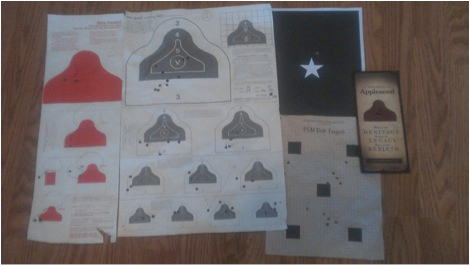 In working on the 25M targets, I was having no success at all with step 6b (calling the shot).
After a good night's rest, I had an epiphany Sunday morning. These targets were designed
for traditional iron sights placed at a 6 o'clock hold. These targets and techniques are
directly from the 1940's army training methods—I'm not sure anyone had conceived a
tactical scope, back then. With iron sights, a perfect sight picture would have the 1" square
sitting directly atop the front sight. If not perfectly aligned when the gun goes "bang", it
should be possible to "call the shot"; but the MTAC wasn't designed for this. First of all, the
black center aiming dot on the MTAC is supposed to be about 2.5 MOA at 100 yds at 4x
magnification. A 1" square at 25yd subtends about 4 MOA; but at 1x magnification—
recommended for all Appleseed events—the MTAC center aiming dot appears considerably
larger than the 1" square at 25 yds (possibly 10 MOA?). So, if I superimpose the aiming dot
over the 1" square, it completely obliterates the square—which is my POA—from view. In
fact, there is room to completely obscure the POA with room to spare. It is no wonder I
could not call the shot when I could not even see my POA! Fortunately, though, the MTAC
BDC reticle is designed to be sighted in (zero) at 100 yards with additional aiming points
for 300, 400, 500, and 600 yards. This would make the POI about 1.5" low at 25 yards. So,
the very first thing I did the next morning was shift to the 300 yd aiming dot. Well, it was a
good idea, but it way overcompensated; but at least I could still see the POA! By trial and
error, I finally discovered that I could place my center aiming dot on top of my 4 MOA
square POA and achieve a good result, with POI about ½" below the bottom of the center
aiming dot. Even the Appleseed instructors did not seem to be familiar with the MTAC
reticle; but once I explained the problem to them, they sighted through my rifle scope and
said "yea, I see what you mean". This reinforced my understanding that the Appleseed is
teaching marksmanship grounded in the techniques and tools of the mid twentieth century,
not necessarily on the tools and techniques of modern warfare.
In working on the 25M targets, I was having no success at all with step 6b (calling the shot).
After a good night's rest, I had an epiphany Sunday morning. These targets were designed
for traditional iron sights placed at a 6 o'clock hold. These targets and techniques are
directly from the 1940's army training methods—I'm not sure anyone had conceived a
tactical scope, back then. With iron sights, a perfect sight picture would have the 1" square
sitting directly atop the front sight. If not perfectly aligned when the gun goes "bang", it
should be possible to "call the shot"; but the MTAC wasn't designed for this. First of all, the
black center aiming dot on the MTAC is supposed to be about 2.5 MOA at 100 yds at 4x
magnification. A 1" square at 25yd subtends about 4 MOA; but at 1x magnification—
recommended for all Appleseed events—the MTAC center aiming dot appears considerably
larger than the 1" square at 25 yds (possibly 10 MOA?). So, if I superimpose the aiming dot
over the 1" square, it completely obliterates the square—which is my POA—from view. In
fact, there is room to completely obscure the POA with room to spare. It is no wonder I
could not call the shot when I could not even see my POA! Fortunately, though, the MTAC
BDC reticle is designed to be sighted in (zero) at 100 yards with additional aiming points
for 300, 400, 500, and 600 yards. This would make the POI about 1.5" low at 25 yards. So,
the very first thing I did the next morning was shift to the 300 yd aiming dot. Well, it was a
good idea, but it way overcompensated; but at least I could still see the POA! By trial and
error, I finally discovered that I could place my center aiming dot on top of my 4 MOA
square POA and achieve a good result, with POI about ½" below the bottom of the center
aiming dot. Even the Appleseed instructors did not seem to be familiar with the MTAC
reticle; but once I explained the problem to them, they sighted through my rifle scope and
said "yea, I see what you mean". This reinforced my understanding that the Appleseed is
teaching marksmanship grounded in the techniques and tools of the mid twentieth century,
not necessarily on the tools and techniques of modern warfare.
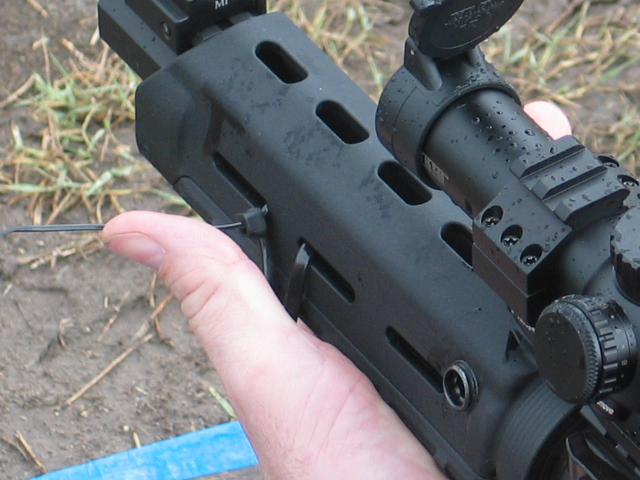
Other targets employed at Appleseed are the "Red Coat" target and the AQT (Army Qualification Test) target. Both of these targets employ silhouettes roughly depicting the upper torso and head. These are scaled for proportionate size of the human frame at 100, 200, 300, and 400 yards when fired at 25 yards. While the economy of required range size is clearly maximized by this setup, I was disappointed that we were not able to move to actual 100+ range targets in this shoot. I recognize that doing so would be logistically complex, so I find myself wondering just how Front Sight manages to accomplish this in the 4-Day Practical/ Precision Rifle courses.
I had one other significant finding regarding the relationship between Barbie and me—we
just weren't a good fit for each other! The instructor helped me adjust the length of pull,
which is simple to do with the adjustable butt
stock on an M4 style rifle; but I was also having a
really hard time with the cheek weld. A
comfortable, repeatable cheek weld left my eye
too low to get a clear, full FOV inside my MTAC.
So, I undertook a bit more "Appleseed
Engineering" and taped some cardboard over the
left side of my butt stock. It was not good enough
to completely resolve this issue for me, but it
definitely was a step in the right direction. After
all, whereas sight alignment is greatly simplified by using a scope, it is still important that
the shooter's eye is aligned perfectly inside the scope. As I compromised to try to achieve a
relaxed NPOA, I took many a shot in positions where a portion of my theoretically round
FOV was truncated on one side or the other. If parallax were a significant issue with the
MTAC scope at 1x (I'm not saying it is), that, too, would have a significant effect on my POI.
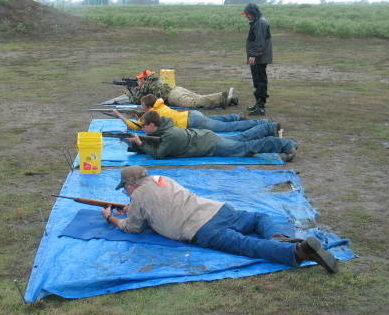 I would be remiss not to say a little bit about the history lessons conveyed at an Appleseed
shoot. The narrative, given during our lunch and afternoon breaks, details the events of
April 19, 1775 in a way I seriously doubt any of you covered this topic in American History
101. While time and space does not allow a complete treatment of this topic, here, the gist
of the tale is that British subjects living in the American colonies stood up to the bullying
of the British Empire and fought back—against their own British armed forces—to secure
independence and the freedom to govern themselves as they saw fit. Had they acquiesced,
stepped aside, and let the British troops disarm them, instead, we might still be speaking
the Queen's English, today! A big part in the ultimate outcome of this struggle is doubtless
owing to the skill at arms practiced by the British colonists in order to form their militias
and protect themselves (against "enemies…domestic").
I would be remiss not to say a little bit about the history lessons conveyed at an Appleseed
shoot. The narrative, given during our lunch and afternoon breaks, details the events of
April 19, 1775 in a way I seriously doubt any of you covered this topic in American History
101. While time and space does not allow a complete treatment of this topic, here, the gist
of the tale is that British subjects living in the American colonies stood up to the bullying
of the British Empire and fought back—against their own British armed forces—to secure
independence and the freedom to govern themselves as they saw fit. Had they acquiesced,
stepped aside, and let the British troops disarm them, instead, we might still be speaking
the Queen's English, today! A big part in the ultimate outcome of this struggle is doubtless
owing to the skill at arms practiced by the British colonists in order to form their militias
and protect themselves (against "enemies…domestic").
I am glad to have gotten the introduction to marksmanship via the Appleseed project. I
learned a great deal. I suspect that I will participate, again, since arranging and financing
trips to NV is somewhat of a strain. At roughly $100 to participate, the two-day, weekend
event is a good way to solidify the fundamental of marksmanship and validate those skills
during the many AQT's that are offered. While employing vastly different approaches, I
find that the purpose and missions of both Appleseed and Front Sight to be in near perfect
harmony. To the degree that each is successful, the result will be more and more American citizens trained to know and appreciate firearms and the role they play in securing our
liberties.